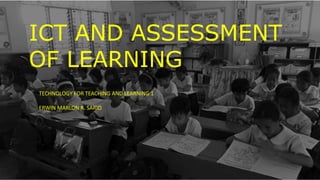
Ict and assessment of learning
- 1. ICT AND ASSESSMENT OF LEARNING TECHNOLOGY FOR TEACHING AND LEARNING 1 ERWIN MARLON R. SARIO
- 2. Assessment is very important in student learning. There are many approaches to assessment in learning with an emphasis on the process of learning along with the product of learning. The ultimate measure of student’s competence is performance.
- 3. Assessment is the process of identifying, gathering and interpreting information about students’ learning. TYPES OF ASSESSMENT 1. FORMATIVE ASSESSMENT – provides feedback and information during the instructional process, while learning is taking place, and while learning is occurring. 1. SUMMATIVE ASSESSMENT – takes place after the learning has been completed and provides information and feedback that sums up the teaching and learning process.
- 5. 3. DIAGNOSTIC ASSESSMENT – can help you identify your students’ current knowledge of a subject, their skills sets and capabilities, and to clarify misconceptions before teaching takes place. Knowing students’ strengths and weaknesses can help you better plan what to teach and how to teach it. 4. AUTHENTIC ASSESSMENT – describes the multiple forms of assessment that reflect students learning, achievement, motivation and attitude on instructionally relevant classroom activity.
- 6. THE ROLE OF ICT IN ASSESSMENT IN LEARNING There are new technologies created to provide students with higher level thinking skills, particularly the aspect of creative and critical thinking, and the opportunity to teach and assess those skills. The use of ICT in assessment is very helpful to teachers because students’ information and results of examination can be recorded and stored and can easily be retrieved. With the use of ICT, the teachers can right away give feedback to students on the result of assessment. Feedback from the computer during the use of test material improves student performance in later use of the same test material.
- 7. CRITERIA IN CHOOSING APPROPRIATE ASSESSMENT TOOLS Assessment methods are the strategies, techniques, tools and instruments for collecting information to determine the extent to which students demonstrate desired learning outcomes. Teachers need to select tools to assess student achievement in the target outcome(s). The selection of tools involves a process to obtain detailed information and the need to keep the process feasible and manageable. Students learning styles vary widely and their strengths and challenges with respect to assessment vary as well.
- 8. Teachers need to consider that variation as they choose assessments for their courses. By varying the way teachers assess student understanding, they are more likely to offer opportunities for every student to demonstrate their knowledge. Many kinds of decisions and many different types of information may be gained from the use of tests and may serve to facilitate decision making. The following may be considered in choosing appropriate assessment tools: 1. Goals of assessment 2. Methods of assessment either direct or indirect 3. The interval of giving assessment
- 9. One of the challenges for beginning teachers is to select and use appropriate assessment techniques suited to the learners’ needs. During teaching, teachers not only have to communicate the information they planned but also continuously monitor students’ learning and motivation in order to determine whether modifications have to be made (Ariasian, 2005). Beginning teachers find this more difficult than experienced teacher because of the complex cognitive skills required to improvise and be responsive to students’ needs while simultaneously keeping in mind the goals and plans of the lesson (Borko & Livingston, 1989). The teacher may either be utilizing direct or indirect method. Example of direct method are examinations, written assignments, oral presentations and performances, internship supervisor’s ratings of student skills, portfolios, score gains between entry and exit tests, capstone projects, theses and dissertations etc.
- 10. Indirect methods can provide a useful supplement and check on the findings from direct measures. The following examples of this indirect method: student satisfaction surveys, surveys of students and alumni, exit interviews with graduating students, student participation rates, reflective essays, data on placement and other measures of post- graduation performance etc.
- 11. Teachers may consider the following characteristics in selecting appropriate assessment tools whether conventional or ICT based assessment: 1. Measure the desired level of performance ( level of satisfaction, productivity, efficiency, student performance) 2. Cost effective in terms of effort, time and money 3. Useful that will produce results that provide information that can be used in making decisions to improve student learning. 4. Reasonably accurate and truthful 5. Dependable, consistent responses over time 6. Evidence of being on-going, not once and done
- 12. Creating and Utilizing Rubric A rubric is a set of criteria used to determine scoring for an assignment, performance or product. This can be used to score many kinds of written assignments or exams, papers, projects, speeches or ePortfolios. They are not useful however as a grading mechanism for multiple choice or short answer tests. There are many samples of rubrics online, but the teacher may consider the learners, objective of the lesson, contextualization and localization. The main purpose of rubrics is to assess student performance. TWO TYPES OF RUBRIC: a. Analytic rubrics describe work on each criterion separately. It utilizes separate holistic ratings of specific characteristics, products or behavior b. Holistic rubrics describe the work by applying all the criteria at the same time and enabling an overall judgement about the quality of the work. It utilizes holistic rating for a product or behavior.
